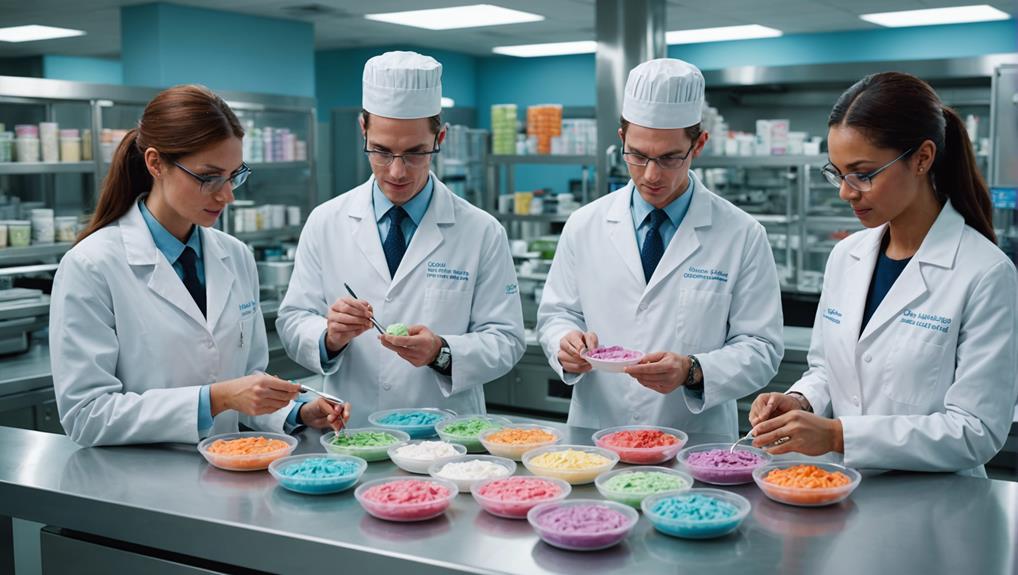The fermentation process in frozen yogurt involves heating milk to eliminate pathogens, followed by inoculation with bacterial cultures like Streptococcus thermophilus and Lactobacillus delbrueckii subsp. bulgaricus. This initiates lactic acid production, important for the yogurt’s tangy flavor and thick texture. Key factors include precise temperature control and ideal pH management to guarantee the viability and metabolic activity of the beneficial bacteria. Fermentation typically spans 4 to 8 hours to achieve desired taste and texture. Proper storage at temperatures below -18°C preserves probiotic viability and product quality. For deeper insights into texture enhancement and health benefits, further details are available.
Key Takeaways
- Heating milk initiates fermentation by eliminating pathogens and preparing for bacterial culture introduction.
- Starter cultures like Streptococcus thermophilus and Lactobacillus bulgaricus are essential for fermentation.
- Fermentation produces lactic acid, resulting in frozen yogurt’s tangy flavor and thick texture.
- Controlled fermentation temperatures ensure optimal bacterial activity and quality.
- Ideal fermentation time ranges from 4 to 8 hours to achieve the desired taste and probiotic concentration.
Basic Overview

The basic overview of frozen yogurt production begins with the heating of milk and the addition of specific bacterial cultures, such as Bifidobacterium spp. and Lactobacillus acidophilus, to initiate fermentation. This process is fundamental in transforming milk into fermented milk products, which form the base of frozen yogurt. The milk is typically heated to a temperature that guarantees the elimination of pathogenic microorganisms while maintaining the integrity of the milk proteins. Upon cooling, the bacterial cultures—including not only Bifidobacterium spp. and Lactobacillus acidophilus but also Streptococcus thermophilus—are introduced.
The bacterial cultures are responsible for fermenting lactose, the milk sugar, into lactic acid. This acidification process leads to the development of the characteristic tangy flavor and thick texture associated with frozen yogurt. Additionally, the metabolic activities of these bacteria contribute to the health benefits of frozen yogurt by potentially enhancing gut health.
In frozen yogurt production, the precise control of fermentation conditions such as temperature and pH is crucial. This ensures optimal growth and activity of the cultures, ultimately resulting in a product that meets both regulatory standards and consumer expectations. The subsequent freezing process must be carefully managed to preserve the viability of these probiotic bacteria.
Key Starter Cultures
Key starter cultures such as Bifidobacterium longum, Lactobacillus acidophilus, Streptococcus thermophilus, and Lactobacillus delbrueckii subsp. bulgaricus play essential roles in the fermentation process of frozen yogurt. These bacterial strains not only contribute to the product’s texture and flavor but also impart significant probiotic health benefits. Effective fermentation temperature control is critical to ensuring the viability and efficacy of these cultures, thereby influencing the quality and consistency of the final product.
Common Bacterial Strains
Common bacterial strains serving as starter cultures in frozen yogurt production include Streptococcus thermophilus and Lactobacillus delbrueckii subsp. bulgaricus. These strains are widely recognized for their vital roles in fermenting milk products, transforming milk into frozen yogurts through a symbiotic relationship. Streptococcus thermophilus and Lactobacillus delbrueckii subsp. bulgaricus work in tandem to produce lactic acid, which lowers the pH of the mixture, resulting in the characteristic tangy flavor and thick texture of frozen yogurt.
The fermentation process facilitated by these live and active cultures also leads to the formation of yogurt acid whey, a byproduct that contributes to the final product’s distinct sensory properties. The presence of viable bacterial strains is essential for maintaining the consistency and quality of frozen yogurt. Additionally, the introduction of probiotic strains such as Bifidobacterium longum and Lactobacillus acidophilus is common, enhancing the health profile of the product.
The specific combination of bacterial strains in frozen yogurt varies among manufacturers, impacting its flavor, texture, and potential health benefits. Consistency in strain viability and activity ensures the repeatability of the desired characteristics in commercial frozen yogurt products.
Health Benefits Explained
Incorporating key starter cultures like Bifidobacterium longum and Lactobacillus acidophilus into frozen yogurt not only enhances its probiotic profile but also offers significant health benefits, such as improved gut health and immune system support. These probiotic bacteria are integral in maintaining a balanced gut microbiota, which plays a vital role in digestive health. Specifically, Bifidobacterium longum aids in reducing gastrointestinal discomfort and enhancing nutrient absorption, while Lactobacillus acidophilus is known for its ability to prevent the growth of harmful bacteria in the gut.
The inclusion of these starter cultures in frozen yogurt leads to the proliferation of beneficial bacteria, which directly contributes to immune system modulation. Probiotic bacteria have been shown to enhance the body’s immune response by stimulating the production of antibodies and reinforcing the gut barrier function, thereby preventing pathogen invasion.
While traditional yogurt bacteria such as Streptococcus salivarius ssp. thermophilus and Lactobacillus delbrueckii ssp. bulgaricus also contribute to gut health, the addition of probiotic-supplemented cultures provides additional health advantages. This dual approach not only safeguards the survival and composition of these beneficial microorganisms throughout the frozen yogurt’s shelf life but also maximizes the health benefits for the consumer.
Fermentation Temperature Control
The process of fermentation temperature control is paramount in activating and sustaining key starter cultures such as Streptococcus thermophilus and Lactobacillus delbrueckii subsp. bulgaricus in frozen yogurt. Effective temperature control is critical for the best growth and metabolic activity of these starter cultures, which convert lactose into lactic acid, thereby contributing to the yogurt’s characteristic tangy taste and creamy texture.
Precise temperature regulation during the fermentation process not only guarantees the proper functioning of these primary bacteria but also supports the proliferation of probiotic bacteria like Bifidobacterium spp. and Lactobacillus acidophilus. These probiotic bacteria enhance the health benefits of frozen yogurt by improving gut health and boosting the immune system.
Temperature control directly impacts the textural properties, flavor profile, and probiotic content of the final product. Inadequate temperature management can lead to suboptimal fermentation, resulting in poor texture and flavor, and diminished probiotic efficacy. Therefore, maintaining ideal fermentation temperatures is essential for producing high-quality frozen yogurt that meets desired sensory and health attributes. The overarching goal is to make sure that the fermentation process is carried out under controlled conditions to achieve a consistent and superior product.
Role of Lactose

Lactose serves as the primary carbohydrate in milk, providing the essential energy substrate for yogurt bacteria during the fermentation process. In the context of frozen yogurt, lactose undergoes a transformation facilitated by bacterial cultures such as Lactobacillus bulgaricus. This conversion is pivotal for producing lactic acid, which imparts the characteristic tangy flavor and viscous texture to the final product. Beyond flavor enhancement, this biochemical activity presents several important implications:
- Fermentation: The breakdown of lactose into lactic acid is a cornerstone of the fermentation process, essential for creating frozen yogurt’s distinct sensory properties.
- Digestibility: The reduction of lactose content during fermentation makes frozen yogurt more digestible, especially for individuals with lactose intolerance.
- Probiotic activity: Lactose serves as a growth medium for probiotic bacteria, which can confer various health benefits, including improved gut health.
- Preservation: The lactic acid produced acts as a natural preservative, extending the shelf life of frozen yogurt by inhibiting the growth of spoilage-causing microorganisms.
Lactic Acid Formation
During the fermentation process in frozen yogurt, bacterial cultures such as Lactobacillus and Streptococcus play a pivotal role in lactic acid formation. These bacteria metabolize lactose, producing lactic acid, which in turn lowers the pH of the mixture. This acidification not only imparts the characteristic tangy flavor but also creates an ideal environment for the growth of beneficial bacteria, thereby enhancing the product’s texture and shelf life.
Bacterial Cultures’ Role
Bacterial cultures such as Streptococcus thermophilus and Lactobacillus delbrueckii subsp. bulgaricus play a pivotal role in the fermentation process of frozen yogurt by converting lactose into lactic acid. This biochemical transformation is fundamental in shaping the tangy flavor and thick texture characteristic of frozen yogurt. The production of lactic acid not only enhances the sensory attributes but also contributes substantially to the preservation of the product by inhibiting the growth of pathogenic microorganisms.
The roles of bacterial cultures in the fermentation process include:
- Tangy Flavor Development: The conversion of lactose to lactic acid imparts the signature tangy taste to frozen yogurt.
- Health Benefits: Certain strains, such as Bifidobacterium spp. and Lactobacillus acidophilus, are incorporated for their probiotic properties, enhancing the health benefits of the yogurt.
- Preservation: The acidic environment created by lactic acid formation acts as a natural preservative, extending the shelf life of the product.
- Texture Modification: The metabolic activities of the cultures result in a desirable thick and creamy texture.
Ph Level Changes
The formation of lactic acid by bacterial cultures precipitates a reduction in pH levels, which plays a vital role in developing the unique sensory properties and microbial stability of frozen yogurt. During the fermentation process, bacterial cultures metabolize milk sugars, converting them into lactic acid. This biochemical reaction results in a decrease in pH levels, which is essential for achieving the tangy flavor characteristic of frozen yogurt.
Monitoring pH levels throughout the fermentation process is critical to guarantee the proper growth of beneficial bacteria and the development of desired flavors. The drop in pH not only enhances the tangy flavor but also contributes to the preservation and textural qualities of the product. Achieving and maintaining the ideal pH balance is necessary for producing high-quality frozen yogurt with the right consistency and taste.
Below is a table illustrating the correlation between lactic acid formation and pH levels during the fermentation process:
| Stage of Fermentation | pH Levels | Lactic Acid Concentration |
|---|---|---|
| Initial | 6.5 | 0.1% |
| Early | 5.5 | 0.3% |
| Mid | 4.5 | 0.6% |
| Late | 4.0 | 0.9% |
| Final | 3.8 | 1.2% |
Ensuring the precise control of pH levels during fermentation is key to producing frozen yogurt with the desired tangy flavor and ideal texture.
Yogurt Thickening

Achieving the desired yogurt thickness hinges on the fermentation process, where specific bacterial strains convert lactose into lactic acid, thereby increasing viscosity and altering the yogurt’s structural properties. During this process, lactic acid bacteria such as Streptococcus thermophilus and Lactobacillus bulgaricus play a pivotal role. These bacterial strains are integral in yogurt thickening as they ferment lactose, leading to the production of lactic acid, which in turn causes milk proteins to coagulate and form a gel-like structure.
The viscosity of yogurt is further augmented by the production of exopolysaccharides (EPS) by certain bacterial strains. These complex carbohydrates enhance the texture by binding water and increasing the yogurt’s consistency. Proper control of fermentation parameters, including time, temperature, and bacterial cultures, is essential to achieve the desired thickness and texture.
Key factors influencing yogurt thickening include:
- Bacterial Strains: Specific strains like Streptococcus thermophilus and Lactobacillus bulgaricus are essential.
- Lactic Acid Production: Conversion of lactose to lactic acid increases viscosity.
- Exopolysaccharides (EPS): Produced during fermentation, contributing to a thicker consistency.
- Fermentation Control: Time, temperature, and culture management are vital.
Flavor Development
Flavor development in frozen yogurt hinges on the careful selection and management of bacterial cultures during the fermentation process. The type and amount of bacterial cultures introduced are pivotal, as they determine the metabolic activities that produce key flavor compounds such as lactic acid, acetaldehyde, and diacetyl. These compounds collectively contribute to the unique and desirable taste profile of frozen yogurt.
The fermentation process involves probiotic bacteria strains that vary in their metabolic processes, leading to distinct flavor profiles and textures. For instance, certain strains may enhance the production of lactic acid, imparting a tangy taste, while others may elevate acetaldehyde or diacetyl levels, adding fruity or buttery notes, respectively. The duration of fermentation also has a significant impact on flavor development. Extended fermentation can lead to more complex and intense flavors due to prolonged bacterial activity.
Temperature control, incubation time, and the ratios of different bacterial cultures are critical parameters that must be meticulously managed to achieve the desired flavor profile. Precise control over these factors ensures that the final product not only meets sensory expectations but also maintains consistency in flavor, important for consumer satisfaction and product fidelity.
Health Benefits

The health benefits of frozen yogurt are primarily attributed to its probiotic content, which can greatly enhance gut health and immune function. Probiotics in frozen yogurt contribute to improved digestion and may assist in regulating blood pressure. Additionally, the Live and Active Cultures seal guarantees the presence of beneficial bacteria, further underscoring its nutritional advantages.
Probiotic Boosting Qualities
Probiotic bacteria such as Bifidobacterium spp. and Lactobacillus acidophilus, commonly incorporated into frozen yogurt, offer significant health benefits including improved gut health and immune system enhancement. These live cultures play a pivotal role in fostering a balanced gut microbiota, which is essential for overall well-being. The presence of live probiotic bacteria in frozen yogurt can be confirmed by the Live and Active Cultures seal, ensuring consumers receive the associated health benefits.
The incorporation of these probiotics in frozen yogurt can lead to several positive outcomes:
- Gut Health: Probiotics aid in the digestion process and help maintain a balanced intestinal flora, essential for nutrient absorption.
- Immune System Enhancement: Regular consumption can bolster the body’s natural defenses by stimulating the production of antibodies.
- Blood Pressure Regulation: Certain strains of probiotics are linked to lowering blood pressure, contributing to cardiovascular health.
- Nutritional Benefits: Greek frozen yogurt, in particular, provides higher protein content and lower fat levels, optimizing its health benefits.
Digestive Health Improvement
In addition to their probiotic-boosting qualities, the live cultures in frozen yogurt greatly enhance digestive health by promoting a balanced gut microbiota and improving nutrient absorption. These fermented products contain essential probiotic strains like Bifidobacterium longum and Lactobacillus acidophilus, which play a pivotal role in maintaining gastrointestinal equilibrium. By fostering a favorable environment for beneficial bacteria, these cultures aid in balancing gut flora, thereby alleviating common digestive issues such as bloating and irregular bowel movements.
The inclusion of probiotics in frozen yogurt supports a robust gut microbiome, which is vital for efficient digestion and nutrient breakdown. This enhanced microbial diversity not only facilitates the absorption of essential nutrients but also strengthens the gut barrier function, providing a first line of defense against pathogenic organisms. Regular consumption of these probiotic-rich foods can greatly bolster the immune system, making it an effective dietary strategy for long-term digestive health improvement.
Moreover, the fermentation process inherent in frozen yogurt production ensures the preservation and viability of these beneficial cultures, optimizing their efficacy in promoting digestive wellness. Hence, integrating frozen yogurt into one’s diet can be a practical approach to enhancing overall digestive health through natural, probiotic means.
Gut Health Impact
Introducing live cultures such as Bifidobacterium spp. and Lactobacillus acidophilus through the fermentation process in frozen yogurt can greatly enhance gut health by maintaining a balanced microbiota. The incorporation of probiotic bacteria plays an essential role in optimizing gut health, as these microorganisms support the fermentation process and produce enzymes that facilitate digestion.
The presence of live cultures in frozen yogurt contributes to the production of beneficial compounds that enhance the gut environment. These probiotic bacteria help in sustaining a healthy gut microbiota, which is vital for effective digestion and nutrient absorption. Specifically, the consumption of frozen yogurt with live cultures has been linked to several health benefits:
- Improved gut function: Probiotic bacteria aid in the breakdown of complex carbohydrates and proteins, making digestion more efficient.
- Enhanced nutrient absorption: Live cultures facilitate the absorption of essential nutrients, including vitamins and minerals.
- Boosted immune system: A balanced gut microbiota can strengthen the body’s immune response.
- Reduction of gastrointestinal issues: Probiotic bacteria can mitigate symptoms of bloating, constipation, and diarrhea.
Fermentation Time

Determining the ideal fermentation time for frozen yogurt is essential for balancing acidity, flavor development, and probiotic content. The fermentation time typically ranges from 4 to 8 hours, contingent on the desired outcomes regarding taste and nutritional attributes. This period is pivotal for the activity and growth of yogurt bacteria, which play a vital role in defining the texture and enhancing the probiotic content of the final product.
A longer fermentation time can result in a more tangy taste and a higher concentration of beneficial bacteria, thereby enhancing the health benefits associated with probiotic content. However, an extended fermentation duration requires meticulous monitoring to prevent over-acidification, which can negatively impact the sensory characteristics of the yogurt.
Implementing a controlled fermentation process is essential for achieving consistent flavor development and maintaining the desired qualities of frozen yogurt. By precisely regulating the fermentation time, producers can ensure a balanced microbial environment, optimizing both the organoleptic and nutritional properties of the product. Consistent monitoring and adjustment of fermentation parameters are critical to maintaining high standards of quality and ensuring consumer satisfaction. Hence, fermentation time is a key variable in the production of high-quality frozen yogurt.
Storage Considerations
Proper storage techniques are imperative to maintain the viability of probiotic cultures and guarantee the quality of frozen yogurt. Ensuring that frozen yogurt is stored at ideal temperatures is essential to prevent bacterial degradation and preserve its sensory attributes, such as texture and flavor. Temperature fluctuations can adversely affect the survival and growth of the beneficial bacteria, compromising the health benefits associated with probiotic cultures.
To effectively maintain the quality and probiotic efficacy of frozen yogurt, consider the following storage guidelines:
- Temperature Consistency: Maintain a consistent freezing temperature, ideally below -18°C, to minimize bacterial degradation and ensure stability.
- Protection from Air Exposure: Use airtight containers to reduce the risk of contamination and freezer burn, which can degrade texture and flavor.
- Monitoring Storage Duration: Follow recommended storage durations, typically not exceeding three months, to optimize probiotic viability and product quality.
- Preventing Temperature Shock: Avoid repeated thawing and refreezing cycles, which can lead to significant bacterial degradation and textural changes.
Adherence to these storage guidelines is essential for preserving the health benefits and overall quality of frozen yogurt. Proper storage practices ensure that consumers receive a product that meets both nutritional and sensory expectations, thereby enhancing consumer satisfaction and product reliability.
Frequently Asked Questions
What Is the Fermentation Process of Yogurt?
The fermentation process of yogurt involves using a starter culture containing specific bacterial strains, such as Streptococcus thermophilus and Lactobacillus bulgaricus, at a controlled fermentation temperature, resulting in lactic acid production and desired yogurt texture.
Is Frozen Yogurt Fermented?
Indeed, frozen yogurt undergoes fermentation, impacting its lactose content, flavor variations, and health benefits. This process is carefully controlled in commercial production to guarantee ideal storage conditions and maintain the integrity of probiotic cultures.
Does Frozen Yogurt Have Active Cultures?
Frozen yogurt indeed contains active cultures, providing probiotic benefits through specific culture strains. These live bacteria, such as Lactobacillus acidophilus and Bifidobacterium spp., contribute to digestive health by promoting a balanced gut microbiome.
How Does Frozen Yogurt Work?
How does frozen yogurt work? By blending various ingredient options, frozen yogurt achieves unique flavor variations, nutritional benefits, and texture differences. Serving suggestions enhance its appeal, making it a versatile and health-conscious dessert choice.
Conclusion
The fermentation process in frozen yogurt involves the intricate interplay of starter cultures, lactose metabolism, and lactic acid formation, culminating in the product’s characteristic thickness and health benefits. For instance, a study on Lactobacillus bulgaricus demonstrated its efficacy in enhancing gut health and fortifying the immune system through its probiotic properties. Understanding these biochemical mechanisms and optimizing fermentation time and storage conditions are essential for producing high-quality frozen yogurt with maximal nutritional advantages.







